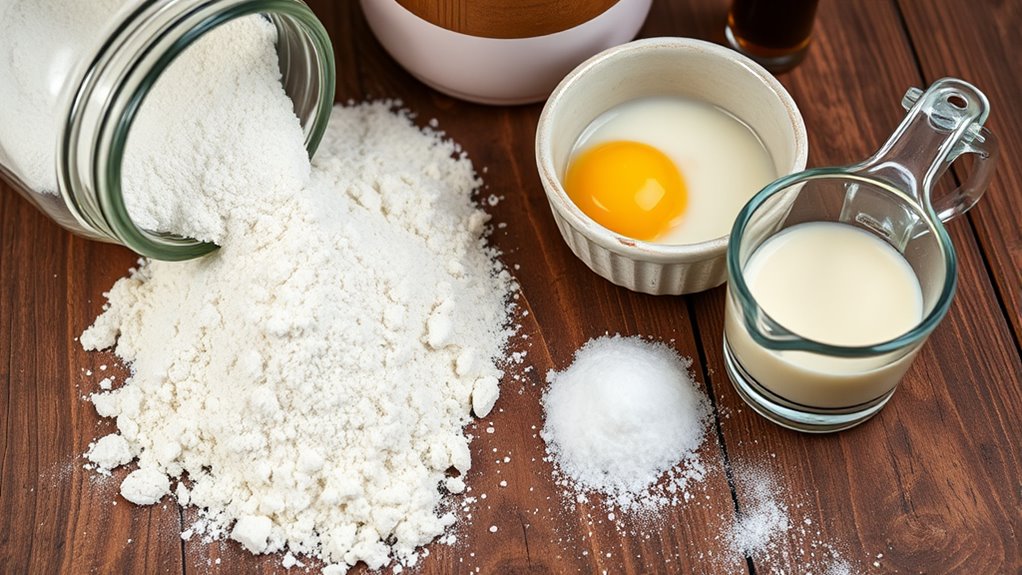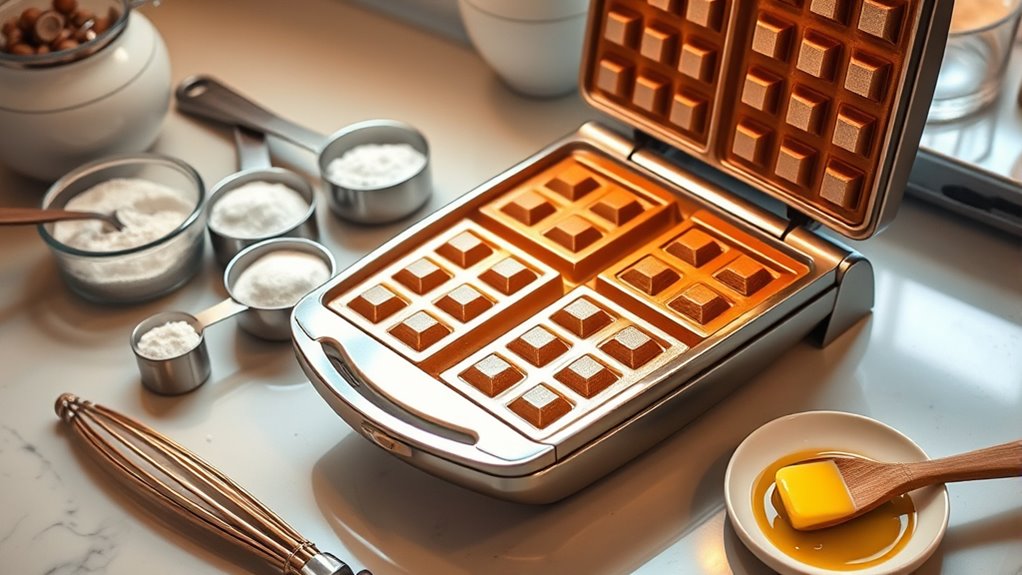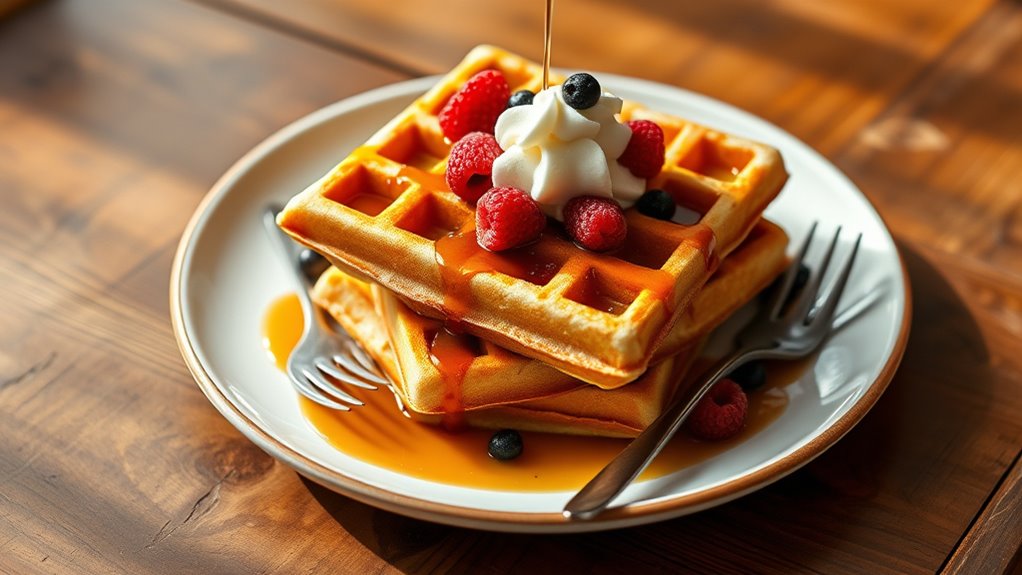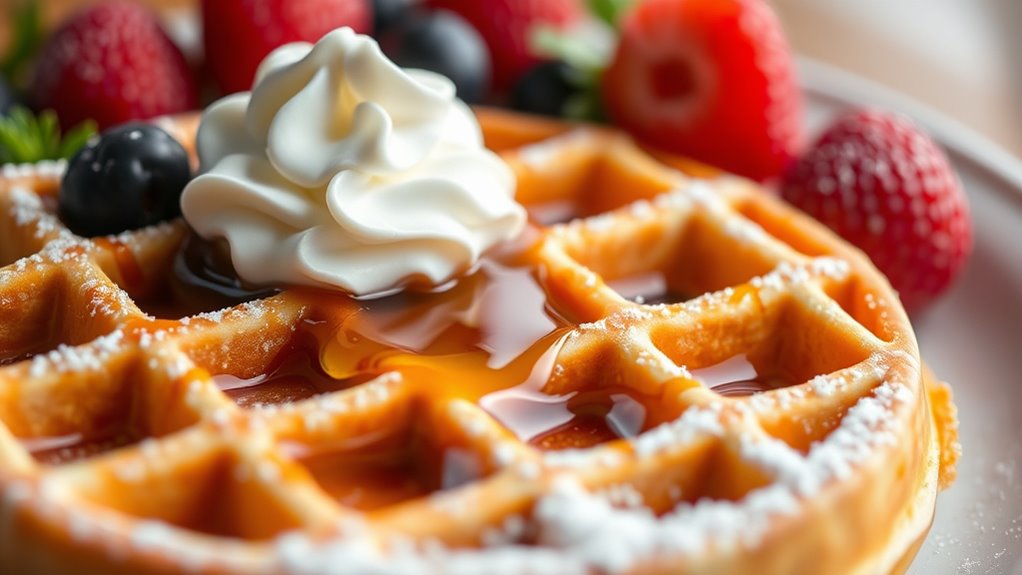To nail the best waffle recipe, first control your ingredient ratios precisely—measure flour, leavening agents, and liquids carefully to achieve the ideal batter consistency. Next, perfect your preparation by combining dry and wet ingredients separately, folding gently to maintain airiness. Finally, use a high-quality waffle iron preheated properly, pouring consistent batter amounts and cooking without interruptions to guarantee crisp, evenly browned waffles. Master these steps, and you’ll reveal deeper techniques to elevate your waffle game further.
Ingredients and Quantity

Before you begin mixing, make certain you have the exact quantities of each ingredient measured out to guarantee consistent texture and flavor in your waffles. Precise waffle ingredients assure your batter’s chemical reactions occur as intended, delivering the ideal crispness and fluffiness. When considering ingredient substitutions, be mindful of how changes affect texture and taste—milk can be swapped with almond milk, but adjust liquid ratios accordingly.
| Ingredient | Quantity | Substitution Example |
|---|---|---|
| All-purpose flour | 2 cups | Whole wheat flour |
| Baking powder | 2 tsp | Baking soda + cream tartar |
| Sugar | 2 tbsp | Honey or maple syrup |
| Milk | 1 3/4 cups | Almond or oat milk |
| Eggs | 2 large | Flaxseed meal + water |
Measure precisely to maintain your freedom to innovate without compromising results.
Preparations

Once you’ve gathered and measured all ingredients accurately, you’ll need to prepare your workspace and equipment to guarantee ideal batter consistency and cooking results. Start by ensuring your mixing bowls are clean and dry to prevent unwanted reactions that could alter texture. Adopt precise mixing techniques: combine dry ingredients first, then gradually incorporate wet elements to avoid lumps and overmixing, which compromises batter consistency. Use a whisk or spatula to fold ingredients gently, preserving air bubbles essential for light waffles. Maintain ingredient temperatures as specified; cold components can thicken batter, while warm ones may thin it unpredictably. Clear your preparation area of distractions to focus on timing and technique—small adjustments here mean freedom to experiment without sacrificing control or quality in your waffle-making process.
Tools / Kitchenware Required

Although mastering the waffle recipe hinges on technique, having the right tools is equally essential to achieving consistent, professional results. You’ll need a high-quality waffle iron for uniform browning and crisp texture. Multiple mixing bowls allow you to separate wet and dry ingredients efficiently, ensuring precise control over batter consistency.
| Tool | Purpose |
|---|---|
| Waffle Iron | Even heat distribution for crisp waffles |
| Mixing Bowls | Separate ingredient preparation for better control |
| Whisk or Mixer | Smooth batter without lumps |
These kitchenware essentials give you the freedom to execute each step with accuracy, minimizing guesswork. Investing in reliable equipment streamlines the process and elevates your waffle-making to an expert level.
How to Cook

- Preheat your waffle iron to the recommended temperature for even cooking and ideal browning.
- Pour a consistent amount of batter to avoid overflow and ensure uniform waffles.
- Resist the urge to open the iron prematurely to prevent disrupting steam release and texture development.
- Maintain the batter moisture balance: avoid overly wet batter to prevent soggy waffles and too dry batter to avoid dense waffles.
- Close the iron firmly to promote crisp edges and a tender interior.
- Cook each waffle until the indicator signals completion or the steam considerably reduces to ensure thorough cooking without burning.
- Follow these steps to master perfect waffle texture every time.
How to Serve

Serving waffles properly enhances both their flavor and texture, so it’s crucial to take into account temperature, toppings, and presentation carefully. Serve waffles immediately after cooking to preserve crispness; a warm plate prevents premature cooling. For topping suggestions, consider fresh berries, whipped cream, or melted butter paired with pure maple syrup for a classic profile. Alternatively, explore savory options like smoked salmon and crème fraîche or avocado and poached eggs to diversify serving styles. Stack waffles for a layered presentation or fan them out in a single layer to showcase texture. Use precise portioning tools to maintain consistency and avoid sogginess. By controlling these variables, you guarantee each bite delivers the ideal balance of warmth, crunch, and flavor, granting you complete freedom to customize your waffle experience.
Tips
To master the art of waffle making, you’ll need to pay close attention to ingredient ratios, batter consistency, and cooking times. Consistency should be smooth yet thick enough to hold shape on the iron without dripping excessively. Experiment with waffle variations by incorporating whole grains or alternative flours for texture and flavor freedom. Adjust leavening agents precisely to achieve crisp exteriors and tender interiors without collapse. Timing is critical—overcooking dries waffles, undercooking leaves them soggy. For topping suggestions, go beyond syrup; try fresh fruit, nut butters, or savory options like smoked salmon and herbs to expand your palate and experience. Always preheat your waffle iron thoroughly to guarantee even browning. By mastering these tips, you’ll create waffles that offer both versatility and consistent excellence.
Food Value and Benefit
Prepared waffles made with whole grain flour, Greek yogurt or protein powder, and healthy fats like flaxseed oil or nuts offer a nutrient-rich meal option. This recipe provides a balanced combination of macronutrients and essential vitamins and minerals, contributing to overall health and well-being.
Food Value of Prepared Waffles:
- High in dietary fiber from whole grain flour, aiding digestion and promoting fullness.
- Rich in quality protein from Greek yogurt or added protein powder, supporting muscle repair and sustained energy.
- Contains healthy fats from flaxseed oil or nuts, supplying essential omega-3 fatty acids.
- Provides important vitamins and minerals including B vitamins (such as thiamine and niacin), vitamin E, magnesium, phosphorus, and zinc.
Benefits of Eating This Recipe:
- Supports digestive health due to increased fiber content.
- Helps maintain and build muscle mass with a good amino acid profile.
- Promotes heart health through omega-3 fatty acids.
- Contributes to energy metabolism and nervous system function via B vitamins.
- Enhances antioxidant protection and immune function thanks to vitamin E and zinc.
- Supplies minerals important for bone health and metabolic processes like magnesium and phosphorus.
Frequently Asked Questions
Can I Make Waffles Ahead and Freeze Them?
Yes, you can make waffles ahead and freeze them effectively. For ideal freezing waffles, cool them completely before placing in airtight containers or freezer bags to prevent moisture buildup. Use parchment paper between waffles to avoid sticking. When ready to enjoy, reheat from frozen using a toaster or oven for crisp texture. These storage tips guarantee your waffles maintain quality and give you the freedom to enjoy them anytime without sacrificing taste or texture.
What’s the Best Way to Reheat Waffles?
Imagine your waffles as golden suns, waiting to shine again. To preserve their crisp edges and fluffy interior, the best reheat methods are a toaster or oven set at 350°F for 5-7 minutes. Avoid microwaves—they turn waffles soggy, ruining waffle texture. This approach guarantees each bite feels fresh, letting you enjoy freedom in your breakfast routine without sacrificing quality. Precision in reheating assures your waffles remain a crisp, warm delight.
How Do I Make Waffles Gluten-Free?
To make waffles gluten-free, replace traditional flour with gluten-free flours like almond, rice, or a blend designed for baking. Use xanthan gum or guar gum to mimic gluten’s binding properties, ensuring proper waffle texture. Adjust liquid ratios, as gluten-free flours absorb differently. Whisking eggs separately and folding them in can add lightness. These precise adjustments let you enjoy waffles with freedom from gluten, without sacrificing the ideal crispness and fluffiness.
Can I Use a Regular Pan Instead of a Waffle Iron?
You can’t replicate waffle texture with a regular pan; it’s like comparing a symphony to a solo instrument. The waffle iron’s unique cooking method creates those iconic pockets and crispness by applying heat evenly on both sides. Using a pan will give you a flat, pancake-like result, lacking that signature crisp exterior and airy interior. For genuine waffles, the specific cooking method is non-negotiable if you want freedom in texture and taste.
What Toppings Pair Best With Savory Waffles?
You’ll find savory waffles excel with toppings like herb-infused cream cheese or sharp cheddar for cheese pairings that elevate flavor depth. Skip traditional syrup; opt for syrup alternatives such as balsamic glaze or spicy honey to balance savory notes. Add sautéed mushrooms or avocado slices for texture contrast. This approach opens up creative freedom, letting you customize savory waffles beyond sweetness while maintaining a technically balanced, rich taste profile.
